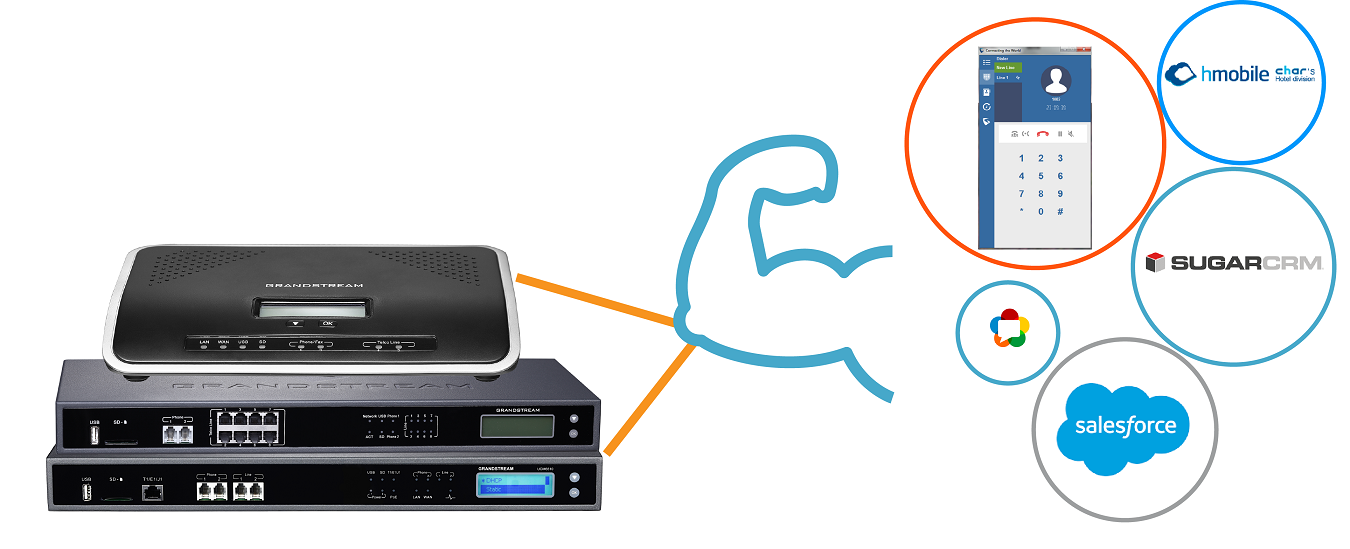Advances in technology in the office environment often move both quickly and slowly
TeleDynamics Think Tank
Guest Blogger
Recent Posts
Hybrid conference phones for every kind of personality
Topics: VoIP, SIP, DECT, Conferencing, Product Review
Five Essential Sales Metrics
By Mike Schmidtmann, Trans4mers
Many telephone dealers and ITSPs aren’t growing because they are breaking fundamental rules of sales. They don’t even realize it! How can you break the rules when you don’t know the rules?
Here’s a metaphor to illustrate this problem and the solution. Imagine playing golf without a scorecard. Now imagine playing without knowing what “par” is for each hole. Wouldn’t that be a bit odd? Disorienting?
Your score in golf is always compared with par. If you shoot a “4” on a hole, you don’t know how good that is until you know what the par is. It could be fair, good, or great depending on whether it’s a par 3, 4, or 5. Of course, if you post a “Snowman," (an 8), that’s bad no matter what the hole is!
Many resellers play a version of this game with sales. How do we know if we are shooting bogies, pars, or birdies? Below, you will find five invaluable metrics that should be on every sales scorecard.
Topics: Customer Service, Business Strategy
You asked, we answered: Grandstream’s GDS3710 facility access solution
Answers to the most frequently asked questions about our HD, IP door phone
By Kate Clavet, Content Marketing Specialist, Grandstream Networks
Grandstream Networks recently came out with our first facility access solution, the GDS3710 an HD, IP door phone. It’s been a huge hit within the industry and we really enjoy using it in our offices, but as with any new product there are a lot of questions. I took this time as an opportunity to answer the most common questions, in one handy spot. Enjoy!
Topics: Business Telephone System, Grandstream, Peripherals, Firmware Upgrades, Home Security
One-way audio issues with VoIP and how to fix them
Are you hearing both sides?
By Kate Clavet, Marketing Specialist, Grandstream Networks
The very technology that makes VoIP so efficient can also indirectly cause one-way audio issues.
VoIP stands for Voice over Internet Protocol (VoIP), indicating that the communication travels over the internet in little packets using RTP (Real-Time Transport Protocol). Since the packets are traveling through the internet, they must pass through firewalls and network address translation (NAT). Due to the tricky nature of firewalls, a common complaint of customers and installers alike is that either the caller or callee cannot hear the other party. Although this is a common inquiry and topic for support tickets, it is also rather easy to fix.
Topics: Business Telephone System, VoIP, SIP, Grandstream, Troubleshooting
The Future of Telecommunications: the Next 25 Years
Quantum-leap technology advancements will enable on-demand services anytime, anywhere, with ubiquitous connectivity.
by Laureen R. Cook, Principal Telecoms, Media and Technology Advisor, IFC (World Bank)
Nordic Mobile Telephony (NMT) was introduced as the first 1G system in the Scandinavian countries in 1982. 2G was commercially deployed in 1992 and 3G launched commercially in 2001, allowing mobile data as a mainstream service. 4G has been deployed since 2012, and is still being deployed around the world in developing markets, and 5G is on the horizon for the early- to mid-2020s. On average, we deploy a new generation of mobile communications every 10 years. In 25 years’ time, we will have deployed 7G and be well underway with design of the specifications for 8G, where wireless high-definition video streaming and virtual reality are part of the everyday norm. We will have transformed ourselves from the Digital Era of the 1990s to 2020, to the Digital Era of Automation from 2020 and beyond, which will be an all-immersive, high-definition user experience, taking us seamlessly from Gigabytes GB = 109 of data to Zettabytes ZB = 1021.
Topics: Wireless, Business Telephone System, Trends, Mobility (including remote work), Network Security, Mobile, Network Design
Don’t fear the shifting industry trends, embrace them!
By Colleen Schmidt, Director of Partner Success, CoreDial
Risk is something that we fear because it requires us to put ourselves out there to achieve something greater. There is always a chance you could lose something important to you, especially if you take a risk on a venture or idea you know little about or have not adequately prepared for. The same is true when it comes to taking risks for your business. As much as we would like to mitigate business risks, the fact is they are an integral part of the growth process for any business. Just ask these business risk takers: Ben Silbermann, the creator of Pinterest, risked everything by leaving a job at Google to create the virtual pinboard site. Ben would survive early disappointments and now presides over a company worth $1 billion. Or Drew Houston of DropBox, who held to his guns when Apple Founder Steve Jobs told him to join Apple or be taken over in the market and now enjoys running a $1 billion company.
For VARs, MSPs and other resellers, your risks may not be the same as the ones mentioned above, but embracing the trends in the industry is the key to long-term success. For the unified communications (UC) industry, taking a risk on hosted and cloud-based services, as well as having a technology partner you can trust, will ensure your business stays economically solvent over time and is ready to meet the changing needs of your customers. Ignoring the shifting tides in the industry will lessen the options you can bring to the table for your customers, which will eventually impact your bottom line.
Topics: Customer Service, Business Telephone System, VoIP, Total Voice Solution, Trends, Cloud
Let Grandstream’s UCM series enhance your internal communications
Sneak preview of new enhancements coming later this year
By Kate Clavet, Marketing Specialist, Grandstream Networks
It’s becoming imperative for any business to have tools available that not only enhance their internal communication but also keep their customers coming back. With so little face time (thanks to the internet), a customer’s experience is increasingly important. Grandstream’s UCM IP PBX series is a practical way to manage your communication without compromising on features or emptying your wallet. After all, we’re always striving to improve our customer’s experience and, by extension, yours.
To maintain a high level of service, there must be tools in place that highlight efficiency and collect data so that customer service, lead follow-up, etc. can be measured. Without metrics and data for evaluation, maintaining a positive customer experience is nearly impossible. Grandstream wants to make that easier for you. In the second and third quarters of 2017, a lot of enhancements are coming your way.
Topics: Customer Service, IP PBX, VoIP, Grandstream, Software Integration, Trends, Productivity
Advanced features of Yealink’s upgraded T4S Series desktop IP phones
The upgraded phone line takes the stack of advanced features even higher.
By Yingting Li, IP Phones Product Manager at Yealink
With the T4 series of IP phones, Yealink offers a well-rounded array of sophisticated calling features, state-of-the-art voice quality, easy installation, robust customization options and extensive expandability. Early in December 2016, Yealink released the upgraded T4S models based on the former T4 series in the North America region. The T4S models build on the user experience even more with a number of upgrades.
Topics: SIP Phones, VoIP, SIP, Yealink, Product Review
How to sell an on-premise IP PBX against a cloud-based ITSP
By Nathan Miloszewski, on behalf of Yeastar
When it comes to VoIP PBX systems, channel partners need to determine whether an on-premise solution or a cloud-based service is best suited for their customer.
Each solution has its strengths. For the instances in which you determine that an onsite IP PBX is the best option for your customer, we’ve put together these guidelines to help you sell against the hosted solutions offered by your competitors. Here at Yeastar, we work with thousands of channel partners who find themselves in competition with cloud-based VoIP service providers and have identified the most compelling arguments for an on-premise solution. Think of each one as an additional arrow in your sales quiver.
Topics: Customer Service, IP PBX, Business Telephone System, VoIP, Total Voice Solution
For a safe new year, you need more than a firewall
By John Macario, SVP of Product Management and Marketing at Edgewater Networks
The beginning of a new year is a time when many business managers reflect on learnings from the previous year and begin working on their goals for the current year. Business continuity and data security are, of course, top priorities and securing the network is a vital part of this.
For network professionals, there is no word more fearsome than “breach.” A security breakdown can mean lost data, stolen secrets, expensive lawsuits, and more. According to IBM, the average cost of a data breach is now US$4 million. This is why nearly every organization that knows what's good for it now invests in antivirus, data loss prevention (DLP), and of course, firewalls.
These days, however, we need to protect more than just data. Enterprise communications have grown into a multi-billion dollar market, particularly due to the widespread adoption of VoIP and unified communications (UC) services. This presents a new challenge that firms will have to face in order to gain a winning edge: voice security. IP phone services present a whole new attack area to potential hackers, a frontier that firewalls simply cannot protect by themselves. The essence of this challenge lies in the fact that we're talking about two entirely different types of information transmission that, in turn, require different security solutions.
Topics: QoS, VoIP, Network Security
Welcome to our Think Tank
In this blog you'll read our thoughts on business telephone systems. While a lot has changed in telecom since TeleDynamics was founded in 1981, we remain as committed as ever to delivering the best customer service in the industry.
If you would like elaboration on a specific topic, please let us know in the comments section.
Happy reading and thanks for stopping by!
Receive New Articles by Email

Recent Posts
Posts by Topic
- 5G
- AI
- Android
- Avaya
- Bluetooth
- Boom Collaboration
- Business Continuity
- Business Strategy
- Business Telephone System
- Case Study
- Catalog
- Cisco
- Cloud
- Collaboration
- Communication
- Conferencing
- Cordless
- CPaaS
- Customer Service
- Customer Success Story
- CyberData
- DECT
- E911
- Events
- Facility Management
- Firewall
- Firmware Upgrades
- FoIP
- Gateway
- Grandstream
- Headsets
- Home Security
- IoT
- IP PBX
- Jabra
- Konftel
- Leasing
- Microsoft
- Mobile
- Mobility (including remote work)
- NEC
- Network Design
- Network Infrastructure
- Network Security
- News
- OTT VOIP
- Outsourcing
- Panasonic
- Peripherals
- PoE
- Polycom
- Power Management
- Product Review
- Productivity
- Protocols & codecs
- QoS
- Regulations
- Routers
- SD-WAN
- SIP
- SIP Phones
- Snom
- Software Integration
- Surveillance
- Switches
- Total Voice Solution
- TP-Link
- Trends
- Troubleshooting
- UCaaS
- Unified Communications
- Videoconferencing
- VLAN
- Voicemail
- VoIP
- VoWi-Fi
- VTech
- WAN Technology
- Wi-Fi
- Wireless
- WISP
- Yealink
- Yeastar
- Zoom
















